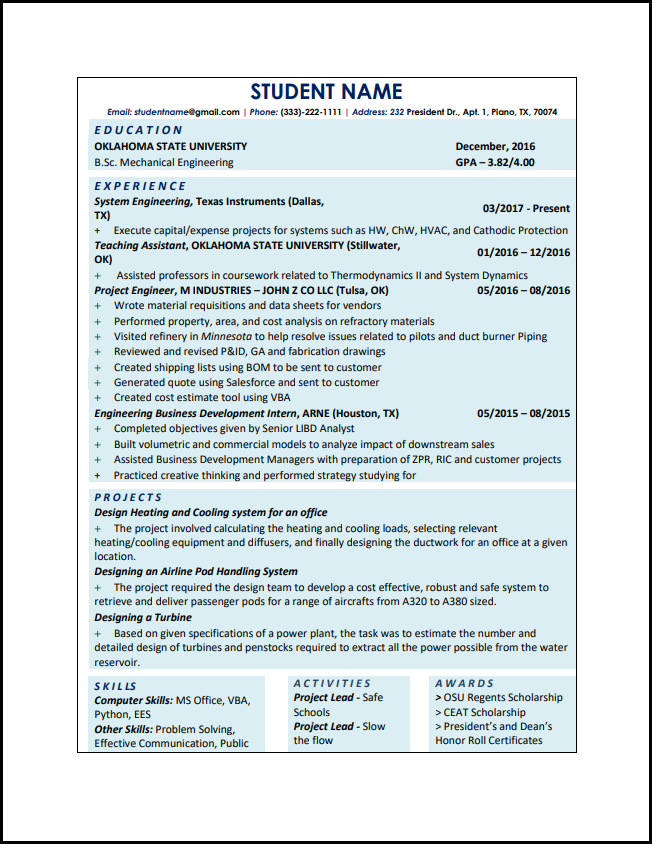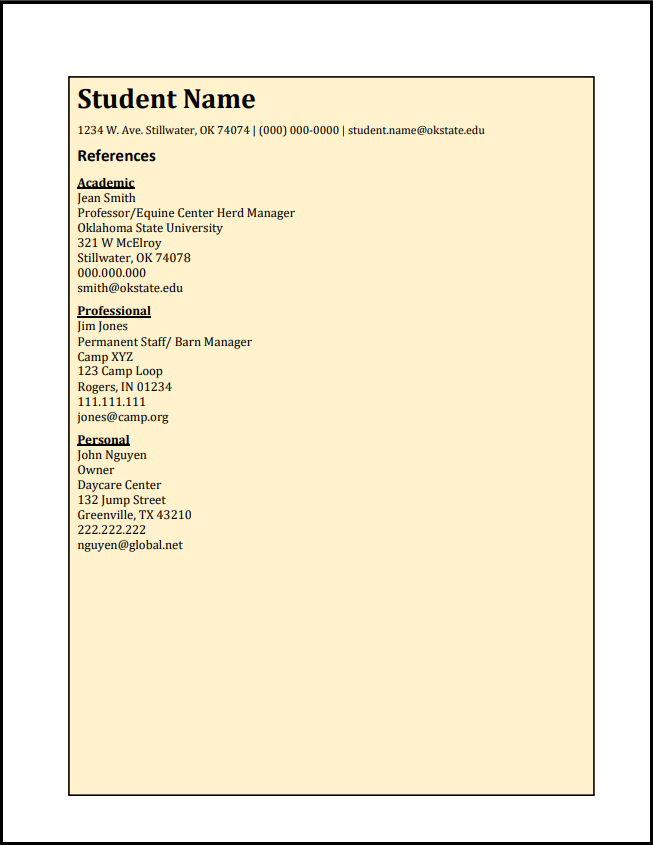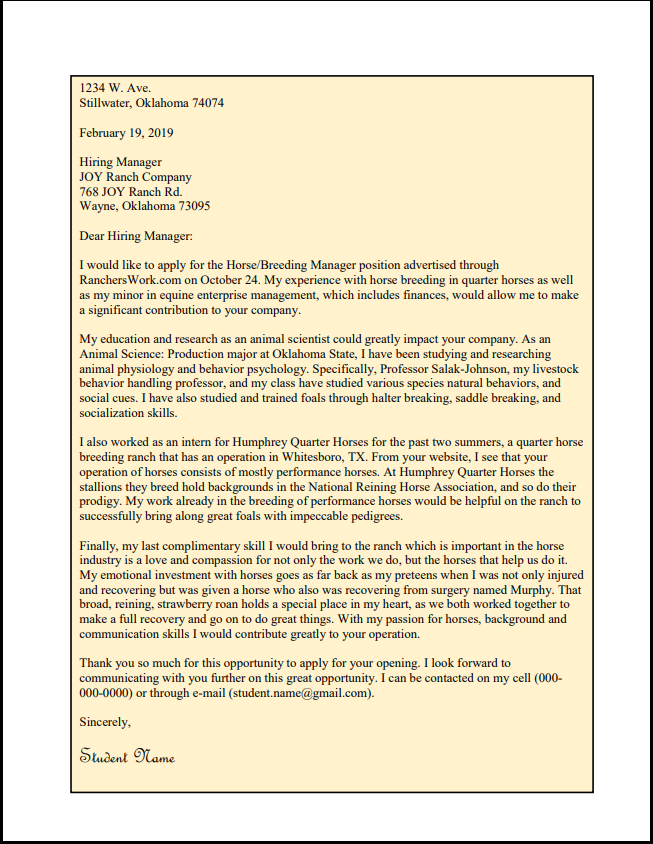Chapter 7: Applying to Jobs
Katrina Peterson
Chapter Synopsis
Looking for and landing the perfect job may seem like a daunting task. If you are uncertain where to start, know that most successful job applicants feel the same uncertainty at some point. This chapter will walk you through the process of applying for jobs from start to finish. Perhaps most importantly, it will provide you with two distinct tools that can help you to construct the materials for a strong, effective, and successful job application: 1) the résumé and 2) the job application letter. Résumés and application letters are among the most important documents in the employment process. Beginning with an overview of the big-picture process, this chapter moves forward with suggested methods for finding job ads and constructing the genre documents for a job packet. In the résumé section, it discusses the following topics: Purposes and Goals, Types of Résumés, Sample Résumés, Drafting and Design: Where to Start, What to Include/Exclude, Optional Sections, and Drafting Activities and Resources. The next section on application letters will share information about deciphering the job description, as well as letter format, structure, and content. The chapter concludes with information on interviews, followed by specific guidelines for the job packet.
7.1 Introduction
Job seeking is a process that involves multiple steps in order to obtain the desired position. Besides the résumé and the job letter, job descriptions, interview questions, writing samples, hiring materials, and the thank-you note sent post-interview are other materials you might find yourself reading and writing as your hiring process moves forward. If the big-picture job seeking process were visualized through a flow chart, it might look something like the following:

Most job candidates begin with research to gain a clear picture of their target (see Step #1 above), or ideal job, along with the company where they would like to be employed. From there, they may think in terms of creating a compelling marketing campaign (Step #2) through a unified job packet. Research (Step #3), of course, will occur throughout this process, all the way up until the interview (Step #4) and through the final stages of negotiating and closing the offer (Step #5). While this graphic helps to visualize both the big picture and some of the individual steps involved, it is only one of many variations of the job application process. This chapter will provide a framework for you to construct your own process (citation clarification: paragraph based on Bay’s above graphic and terminology, though written by me). As you research and pursue job choices, keep in mind that the job search process requires a high degree of self-awareness—not only of strengths, but also of weaknesses. In general, most people find it easier to identify and discuss their strengths. However, knowing your weaknesses is just as important to your job search as knowing your strengths. Here are a few reasons to be able to speak fluidly and confidently about weaknesses:
- Employers want to hire individuals who are self-aware, which requires an awareness of both strengths and weaknesses. Being self-aware is the only way to improve.
- During an interview, a prospective employer may ask about strengths and weaknesses. Employers know it takes a certain level of maturity to talk about your weaknesses. They want to ensure you have achieved that level of maturity before extending an offer.
Remember that everyone has strengths and everyone has weaknesses, including every CEO, every president, every manager, and every one of your coworkers. You will be in good company when considering and discussing your weaknesses. The trick, if there is a trick, to your weaknesses lies in your plan to strengthen them. Having a plan to strengthen a weakness is impressive, especially if you have already taken steps to do so.
7.2 Finding Job Openings
Investing the preparation time to write your employment materials, including researching available positions, can save you many headaches in the job process. Finding a suitable opening itself can be time-consuming; if you are serious about finding employment, you have to dedicate the time and energy to make your materials competitive. Here are some resources to get you started:
- Job boards: Browse sites like Indeed, CareerBuilder, Glassdoor and Monster to search for jobs in your field.
- Specialty job lists: Look for lists of jobs in specific industries such as food service (Poached), nonprofits (Idealist), or media (MediaBistro).
- Company, organization and government web sites: Visit the employment section on websites of companies you admire; search federal, state, county, and city websites for government job postings.
- Your own network: Talk to friends, past employers, and professors or visit LinkedIn to search for openings at companies in your network. If you are a member of any social media groups that are career-oriented, check for mention of available jobs there.
- Your college: Visit your college or university placement office/career center and attend job fairs hosted at your college.
- Craigslist: Many job seekers also use Craigslist to look for work; just be aware that Craigslist postings often lack detail and may come from headhunters or placement agencies, rather than from the direct employer. Scams have also been reported on Craigslist job boards, so verify the legitimacy of any posting before providing personal details.
Once you have found a job, be sure to print and/or save a copy of the job posting or job description. You will use this document to help you tailor your application materials. Companies often delete the job posting once they have received sufficient applicants, so it is important that you save your own copy of the document, along with the date and location you found it (this information is often referenced in the job letter); you might also copy and paste the text into a new document, or bookmark the webpage.
7.3 Constructing Modular Materials
It probably sounds like a lot of work to create a new set of employment materials for every job opening you will identify. While it is true that it takes time and effort to customize application materials for each new job application, you do not have to create a new résumé and cover letter for every job opening. Instead, you can create modular materials with moving parts that can be adapted and reorganized for each job.
For example, if you are a nursing student wanting to work in a different (or indirectly related) field during school, you might consider applying to be an administrative assistant, a medical translator, or a biology tutor. Several different résumé formats are available to you. However, you may choose the functional (skills) résumé format to place more emphasis on a specific set of current qualifications and slightly less emphasis on your education or work experience; you might create three different templates of your résumé that emphasize and expand upon different skill categories: administrative, communication, and educational.
The same holds true with the application letter. Once you have a letter draft, you can work with it as a template for numerous other jobs, keeping the overall format but revising some key sentences. It is quite likely that the final paragraph of your cover letters will change very little if you are applying to multiple jobs within the same career field or industry. The central paragraphs, on the other hand, may undergo substantial revision, depending on how different one potential job is from another. Just make sure to change the name of the potential employer and company for each application; addressing a potential employer by the wrong name is the surest way to remove your materials from consideration.
7.4 Crafting Résumés
The purpose of a résumé is twofold: first, to serve as an overview or quick summary of your skills, experience, and education as they relate to your career objective; secondly, to function as a marketing tool that conveys your personal brand. All of us want our résumés to stand out from the stack. The best way to create an eye-catching résumé is not through gimmicks or flash, but rather through substance and customization. As a marketing document that sells your candidacy, your résumé should have a format that is pleasing to read, efficient in its use of the English language, and very concise. Once you have several years of experience, it is acceptable to have a two-page résumé; the average résumé is now two pages in length, although résumés may range from one to three pages. You should aim for a full page as you are building experience and generating content.
Regardless of your starting point—whether you are unsure you can fill a two-page résumé, or whether you think it will be difficult to fill a single page—this chapter will help you accomplish your goal: designing an exceptional résumé. Remember, as the most critical component of a marketing campaign in which you advertise your professional self, your résumé must be clear, concise, and error free. Most seasoned recruiters scan a résumé in about seven to twenty seconds; because they have many documents to review, they look for reasons to reduce the number of résumés that demand a second look. This means that a single error can be all that is needed to discard your résumé and your candidacy. However, recruiters also have an eye for key details, so they will quickly recognize a well-constructed résumé and discard one that is poorly designed.
While writing your résumé, it is important that you keep in mind not only its purpose, but also its general goals, which include the following:
- To make an exceptional first impression. Your résumé will likely be the first impression a potential employer has of you and your qualifications, so it must hold attention long enough to propel your job search forward.
- To quantify strengths, responsibilities, abilities, and accomplishments. Mentioning factual, numerical examples of praiseworthy attributes and skills will allow you to boast without sounding boastful
- For example, if you reduced errors by 35% and increased profits by 55%.
- If you have been a student teacher with 35 students and student grades improved by 25%.
- If you are part of a marketing team that has increased new patient accounts by 10% last
- If you worked in the school library and the number of lost books has declined by 50%.
- To argue, in an articulate and polite way, that you are well suited for the job. Based on the content of the job ad, you will want to address how your education and/or work experiences (including internships and volunteer work) have taught you both technical and “soft” skills that will help you perform the listed job duties.
- To represent you when you are not there. Your résumé can be uploaded to onlineglobal job boards like Monster and CareerBuilder. It can be sent to a company’s online database with a push of a button, where it will be shared with dozens of recruiters and hiring managers.
- To obtain an interview and create talking points. Listing your accomplishments and quantifying them can create talking points for future interviews. For example, perhaps you bullet point the following: Responsible for intake and outtake of approximately 1,000 books daily, resulting in 80% fewer lost books this year. During an interview, with this example in mind, you can easily talk about using technology to improve processes. You can discuss the team environment of the library staff and how you worked toward decreasing the number of lost books.
- To show your command of the written word. You do not have to be an English major to make sure that your résumé is well-written. Your professors, teachers, peers, and family members may be willing to help by answering questions based on their expertise, or even reviewing a résumé draft.
Overall, highlighting specific results in each résumé category will increase your chances of getting your résumé noticed. Unlike financial investments, past performance is an indicator of future success: include details about your past performance and quantify your accomplishments whenever possible, and future employers will be inclined to believe you can do the same for them. What exactly do you do, or what have you done in the past? Your résumé should answer this question very quickly. The more you quantify your accomplishments using specific details, the more your abilities will be understood.
For example, stating that you “worked in sales” on your résumé does not provide specific proof of your skills—and therefore is not likely to be as impressive—as a statement that quantifies your experiences and provides unique details. Stronger examples of résumé statements might include: “completed an average of 65 customer transactions per hour, setting a company record for the 2019 fiscal year” or “managed national and international supplier accounts with purchase ranges from $1,000 to $10,000,000 USD.”
Types of Résumés
Just as work histories come in a variety of forms, so also do résumés. Although career experts debate which style is the best, you must decide which fits your current situation. There are many reasons to choose one format over another. The chronological résumé is the most common résumé format. It is best for candidates with a long/uninterrupted work history, in fields where the company worked for is of paramount importance. It is also well suited for those applicants who want to highlight their education, as many jobs will ask for a degree (e.g. BA, JD, MBA, MA, MD, PhD, etc.) in a certain field as a minimum requirement. In contrast, the functional (or skills) résumé serves candidates who are transitioning between fields, who are shifting from a military to a civilian career, or who have gained skills in a variety of different settings (workplace, academic, volunteer). The following information offers an overview of these two best-known formats. Visual examples are given in the section afterwards, followed by suggestions on where to begin a résumé draft or how to develop your current draft further.
- The chronological résumé is a traditional format whose principal section is the Employment Experience section. In this section, jobs are listed in reverse chronological order (starting with the most recent positions/schools and working backward), and achievements/skills are detailed underneath each position. The chronological résumé presents experience under headings by job title, company, location, and dates of employment. Education is another common category that, like all sections on a résumé, is also in reverse chronological order. While the chronological résumé dedicates the majority of its space to providing relevant details from previous work experience, the education section is often placed above the work section.
- In contrast, the functional (skills) résumé, centers around well-developed Skills & Achievements section, in which skills are organized into categories. The functional résumé still includes an Employment Experience section and likely an Education section, but these sections are streamlined to include only the basic information about each position held or each school attended. The functional résumé focuses on skills and experience, rather than on chronological work history. It describes responsibilities, accomplishments, and quantifiable achievements under categories in the skills section. The functional résumé typically opens with a brief summary/profile detailing strengths (one to three sentences) and demonstrates how you match the requirements of your potential job by including relevant achievements and accomplishments.
It is worth noting that, especially in the case of advanced positions, many recruiters expect to see a chronological résumé with traditional sections like employment and education. In most cases, it is best to give recruiters the résumé they expect. However, both the college student and the more experienced candidate may choose a functional résumé for these reasons:
- To highlight skills and achievements rather than past employment/companies.
- To minimize a less-than-extensive work experience history.
- To emphasize other achievements, honors, and abilities.
- To de-emphasize gaps in employment or career mobility.
- To include categories like communication, teamwork, and leadership skills, as well as volunteer experience or athletic achievements.
Sample Chronological Resume (check attribution, student sample)
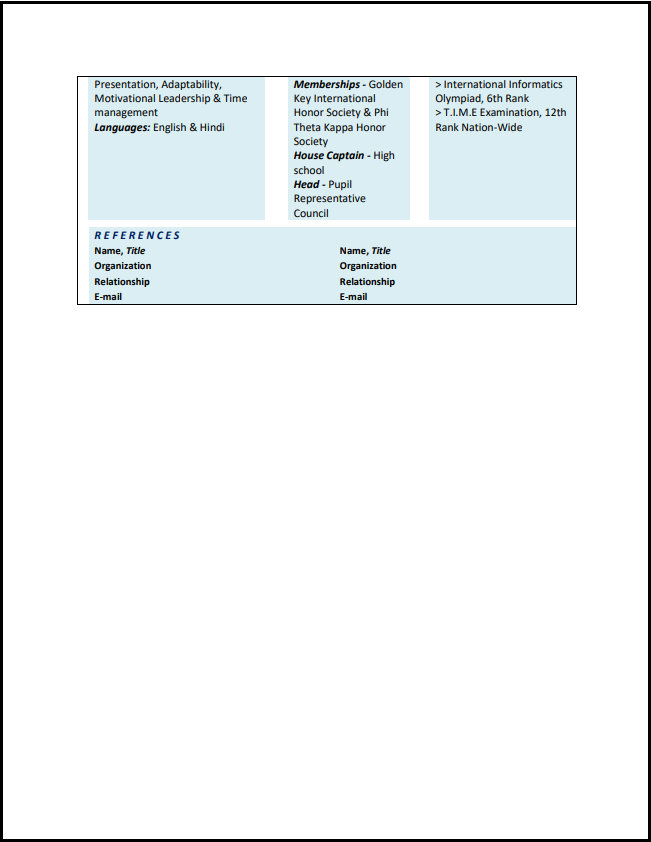
Click here to download a copy of the example resume in Figure 2
Sample Functional Résumé
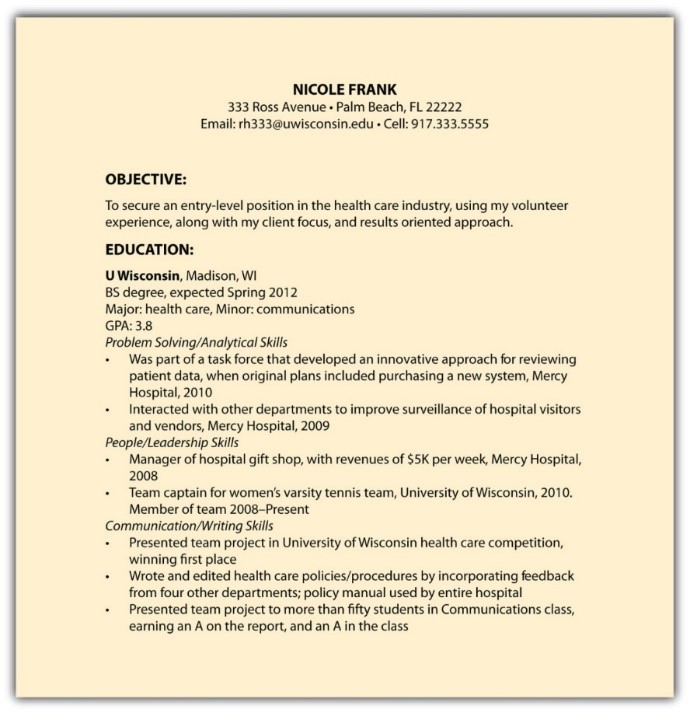
Drafting and Design: Where to Start
Concerned about where to begin when drafting your résumé? Here are a few general guidelines and tips. Based on your qualifications, goals, and job ad, first use the information from the previous section to choose from the two major résumé types. You might consider using a template as a helpful starting point. However, if you do use a common template to help with layout and section format, be sure to modify it in some way so it does not look identical to another candidate’s résumé. As you modify your chosen résumé type and template, keep in mind the following information on basic design features and conventions.
Design Conventions
- Use tables to align sections, then hide the borders to create a neat presentation.
- Choose a standard ten-to-twelve-point font such as Times New Roman.
- Use the same font in your résumé and your cover letter to create coherence.
- Choose a font that looks serious and professional and is easy to read.
- When describing work experience (and possibly education), include bullet points. Start your bullet with an action verb describing a skill or achievement. Follow it with the details of that skill or achievement, and then describe the positive impact of your achievement. For example: Developed (VERB) new paper flow procedure (DETAILS), resulting in reduced staff errors and customer wait times (RESULT); Provided (VERB) friendly customer-focused service (DETAILS) leading to a 15% improvement in customer satisfaction and loyalty (RESULT).
- Avoid relying on graphics or ornate design feature. Too many design features may make the résumé look busy.
- Be strategic and consistent in your use of capitalization, bold, italics, punctuation, and underlining.
- Place more space between sections than within a section to create visual groupings of information. This way your reader will be able to easily distinguish between the key sections of your résumé, and between the items in each section.
- Write in sentence fragments that begin with active verbs and leave out sentences’ subjects. Example: “I eliminated the duplication of paperwork in my department by streamlining procedures” would become “Eliminated paperwork duplication in a struggling department by streamlining procedures.”
- Place your name at the top of the résumé to make it obvious to readers that you are the subject of each verb.
- Learn about field-specific conventions. The conventions in your field or industry will affect your choices in writing your résumé. Length, formality, design, delivery method, and key terms are just some of the factors that may vary across disciplines. Ask faculty or professional contacts in your field about employers’ expectations, visit your school’s career center, or conduct web research to make informed field-specific choices.
- Quantify your skills and achievements, as explained previously. This means including references to technologies and equipment you have used; types of documents you have produced; procedures you have followed; languages you speak; technical languages you know; types of clients you have worked with (demographic information that might be relevant in your new workplace); and so on.
- Avoid filler words, or fluff that does not show meaningful skills. Filler words include: team player, results-oriented, fast-paced, and self-motivated. If you MUST use these phrases, find concrete examples to back them up. For example, instead of using team player, include a time you “collaborated with peers to save the company over $500/month on delivery methods” or “co-managed a team of six to interview/hire vendors for annual company picnic.”
- Use key terms gathered in your pre-writing, preparation phase (from the job description and research into your field). If your potential employer is using a résumé-scanning program, these key terms may make the difference between getting an interview or a rejection.
- Make sure your résumé is completely error free. Proofread your résumé several times, use spell check, and ask an exceptional proofreader to review it. Always assume that an error lurks somewhere in your résumé and review it until you find that error!
What to Include and Exclude
Despite variations in résumé type, formatting, and design, there are understood rules of thumb on what to include and exclude. Here are a few general guidelines on what to exclude. For example, high schools, no matter how prestigious, should not be included in a résumé. Also avoid including sections with titles like Hobbies or Other, with interests that may seem irrelevant to the position: golfing for business jobs, video game play for software design jobs, and blogging for PR jobs have little direct bearing on your professional training.
In a North American context, never include information like height, weight, or marital status, as this information is unrelated to your qualifications and might become a source of discrimination. Similarly, although you may have seen résumé samples that include a picture (this may be common in some cultural contexts), it is non-standard and strongly discouraged in the United States to include a photo with the job packet. It may also be a good idea to be appraised of your legal rights when working through the job process, from application to interview. To become more aware of protections guaranteed by federal law, you may want to review a resource like the following, published by the U.S. Equal Employment Opportunity Permission: https://www.eeoc.gov/facts/qanda.html.
Now that you know what to exclude, what information should you include in a résumé? As their foundation, most résumés integrate three sections or types of information: the résumé header with contact information, education section, and work experience.
Résumé Headers
First of all, your Résumé Header should include four items: full name, address, email address, phone number, and possibly your professional website or Linkedin page. If your first name is difficult to pronounce, you could include your nickname in quotation marks or parentheses (e.g., Xioang “Angie” Kim or Massimo “Mass” Rapini). Names are typically bolded and centered on the page, but aligning your name to the right or left is also appropriate, depending on the template or style you have chosen. You may include your school address or your permanent home address, or both. Most recruiters prefer both because, at times, they may need to send information to both addresses at different times of the year.
As noted in the chapter on email etiquette, it is important to choose a professional e-mail address because employers frown upon addresses such as greeneyes2@gmail.com or runningguy62@verizon.net.
Instead, consider using your first name and your last name in a simple email format. If you continue your job search after graduation, you might not be permitted to use your school email address, nor should you once you have graduated. Include only one phone number on your résumé and record a professional voicemail in case the employer calls. Do not play music on your voicemail. If in a loud area, do not answer your cell phone, especially when you do not recognize the number. Allow the call to go to voicemail, listen to it in a quiet place, and return the call as soon as possible. A professional voicemail might sound like the following: “You’ve reached John Smith at 555.555.5555. Please leave a message and I will call you back as soon as possible.” Be sure to check your voicemail on a regular basis.
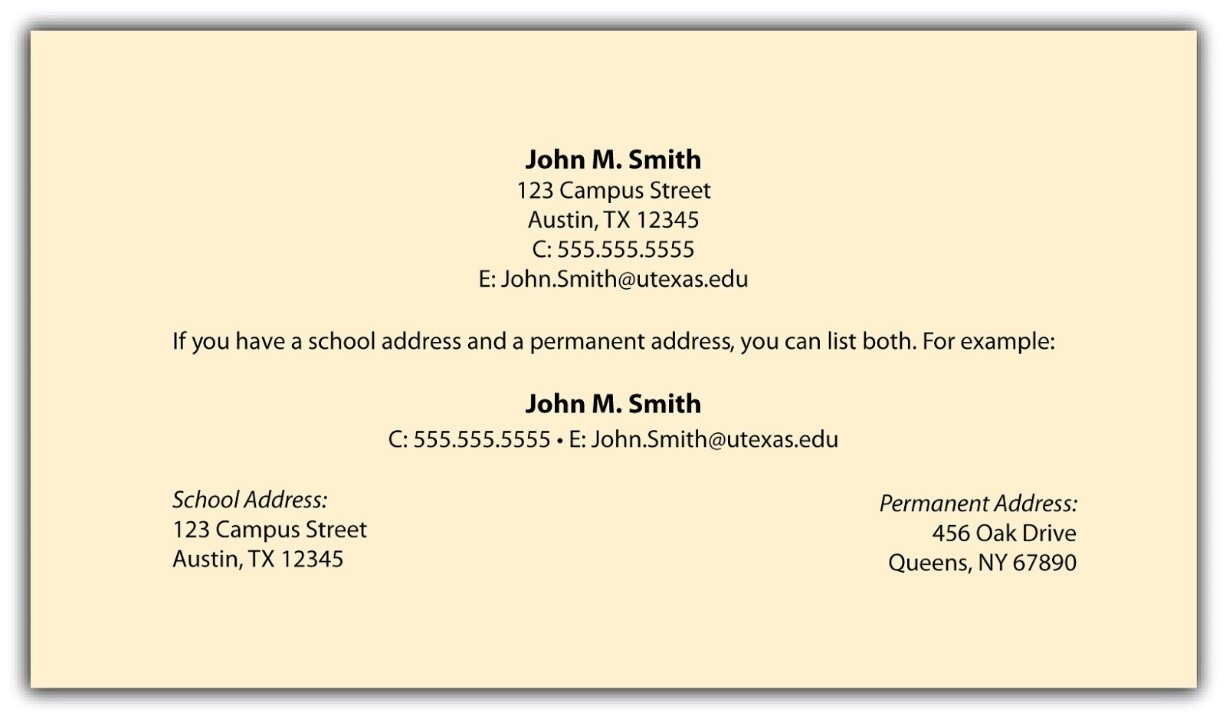
Education Section
Secondly, the Education Section will likely appear before your experience section. Once you are a working professional, you may choose to flip these two sections, in order to emphasize the information that is more important to a particular employer, or to follow the conventions in your field. Within the education section, it is standard to include your GPA, typically if it is 3.0 or better, along with your expected graduation date, major(s), and minor(s). You may include your overall GPA, or you may decide to list the GPA of your major. Certain industries are more concerned with GPA than others, including consulting, investment banking, and trading, which can require a 3.6 or 3.7 and above.
Be sure to research each industry to familiarize yourself with such requirements. If you attended only one college, only that college should be listed in this section. If you transferred from another college, you should list both schools in this section. The first school you list is the current school you attend, followed by the previous school. If you attend graduate school, law school, and so forth, your postgraduate institution would be listed first. You also have the option of including relevant courses that prepared you for the job you are seeking and any special accomplishments related to school—like projects, offices held, service, and awards or scholarships. If you have many of the latter, you might alternatively consider placing them in their own section marked Honors.
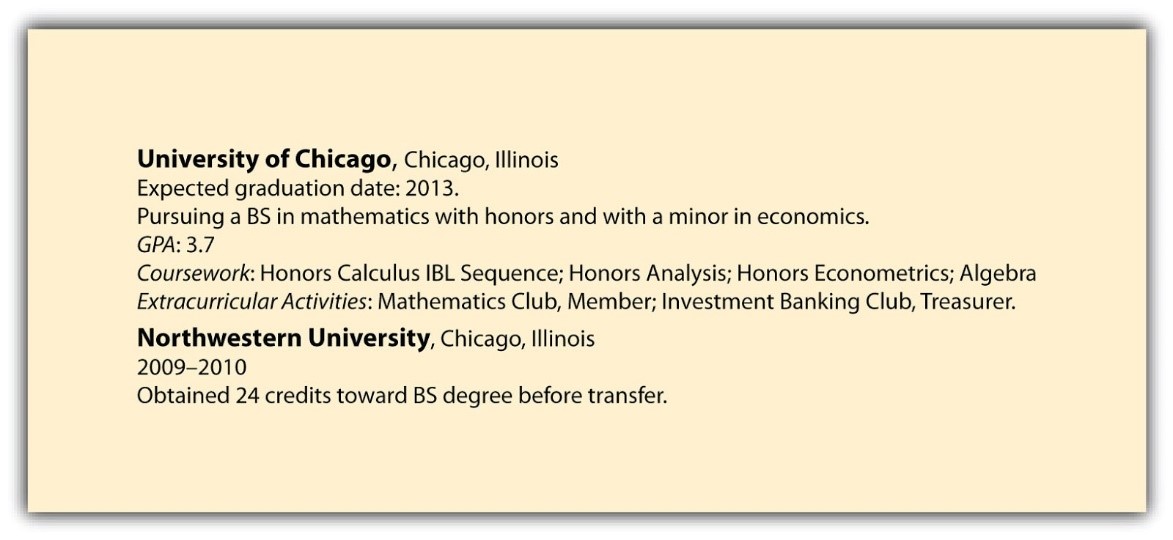
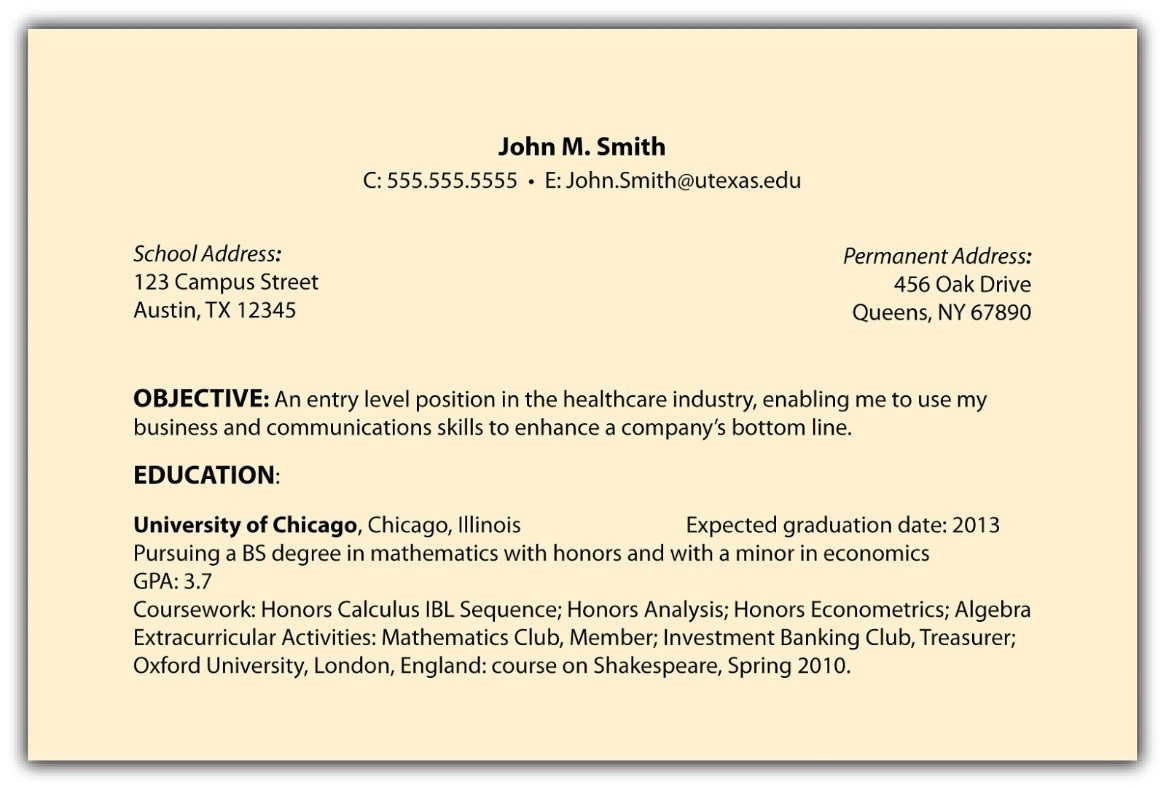
Employment Section
Thirdly, the Employment Section should highlight most the most relevant jobs you have held and downplay less significant experience. This section is arguably the most important of your résumé because recruiters often look for past work experience as a predictor of future work experience. The conventional method of listing your work experience is in reverse chronological order (as with your education section). List your most recent job experience first and include the following information:
- The name of the company.
- The city and state and, when outside the United States, the country.
- The years of employment. (If you have had several jobs at one company, include the overall years of experience; for separate jobs, note specific years of experience.)
- Three to seven bullet points describing your responsibilities and the results of your work, depending on years of experience.
As noted in the section on design, you should use bullet points as a means of clearly and succinctly listing your responsibilities and achievements.
Optional Sections
In addition to contact information, education, and work experience, you may be wondering what other sections to include while developing résumé. Your options are many, but here are a few additional ideas.
- Objective Statement: This statement is increasingly controversial—some sources will recommend that you include an objective statement, while others will warn strongly against it. Proponents will tell you that recruiters appreciate clarity, and an objective can help a recruiter understand exactly what you offer or what business would best suit your background. Naysayers argue that the résumé is meant to be scanned in a matter of minutes and the objective statement only slows this process down with details that will likely be explored in the cover letter. If included, objective statements should be very targeted and mention a specific position. Whatever objective you choose, it should be highly specific in stating what you are looking for and what you have to contribute. It should also be you-centered, showing what you can do for the company in no more than two sentences.
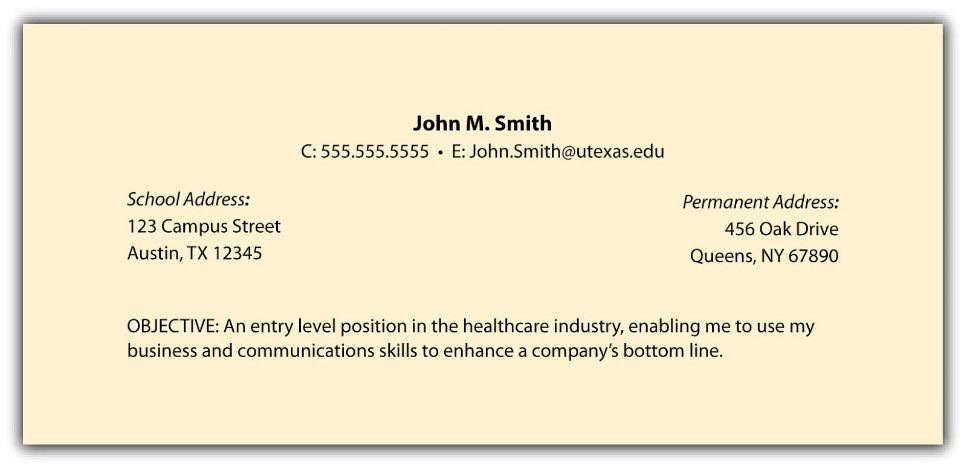
If you are unsure about including an objective statement, or if it would be too vague and general, it is best to omit it altogether.
Here are a few examples of possible objective statements:
-
- An entry-level accounting position in auditing, allowing me to use my analytical and detail orientation to ensure accuracy in all reports and reviews.
- A communications internship at a top media company that will allow me to use my knowledge and experience to produce and edit clear and effective communications.
- An entry-level position in the healthcare industry, enabling me to use my business and communications skills to enhance a company’s bottom line.
Consider the above examples to be a general starting point. In writing your objective statement, you would want to use the specific job title as it is given in the job ad or on the company website (with proper capitalization), and you would likely want to state the company name as well. This shows your focused intention to apply for a specific job position at a specific company, rather than producing a one-size-fits-all résumé that lacks focus.
- Skills and Additional Information: This section of your résumé includes, but is not limited to, the following information.
- Computer Skills: Most employers expect Microsoft Word, Excel, and PowerPoint, but include additional software knowledge (e.g., Dreamweaver).
-
- Language Skills: Include your honest level of fluency (e.g., Spanish, fluent, French, beginner).
- Study Abroad: Include the name of the university, the city and country, and the coursework.
- Community Service: Include any volunteer work, such as park cleanups, walk-a-thons for various causes, or fundraising events of any kind. Be specific about your responsibilities and your results including dollars raised, hours spent, leadership position, end-user experience (e.g. fund-raising efforts reached over $20K, providing for five developmentally disabled students and their parents to travel to Florida to swim with the dolphins).
- Licenses and Certifications: Individuals can achieve literally hundreds of professional licenses in the areas of health care, finance, real estate, insurance, and so forth. Examples include Chartered Financial Analyst (CFA) Level I or Licensed Real Estate Agent.
In constructing this section, be sure to keep in mind your options. If you want to highlight certain information, or if you need to add a lot of detail, you might consider making a separate section for an item, or you might decide to combine similar items within the same section.
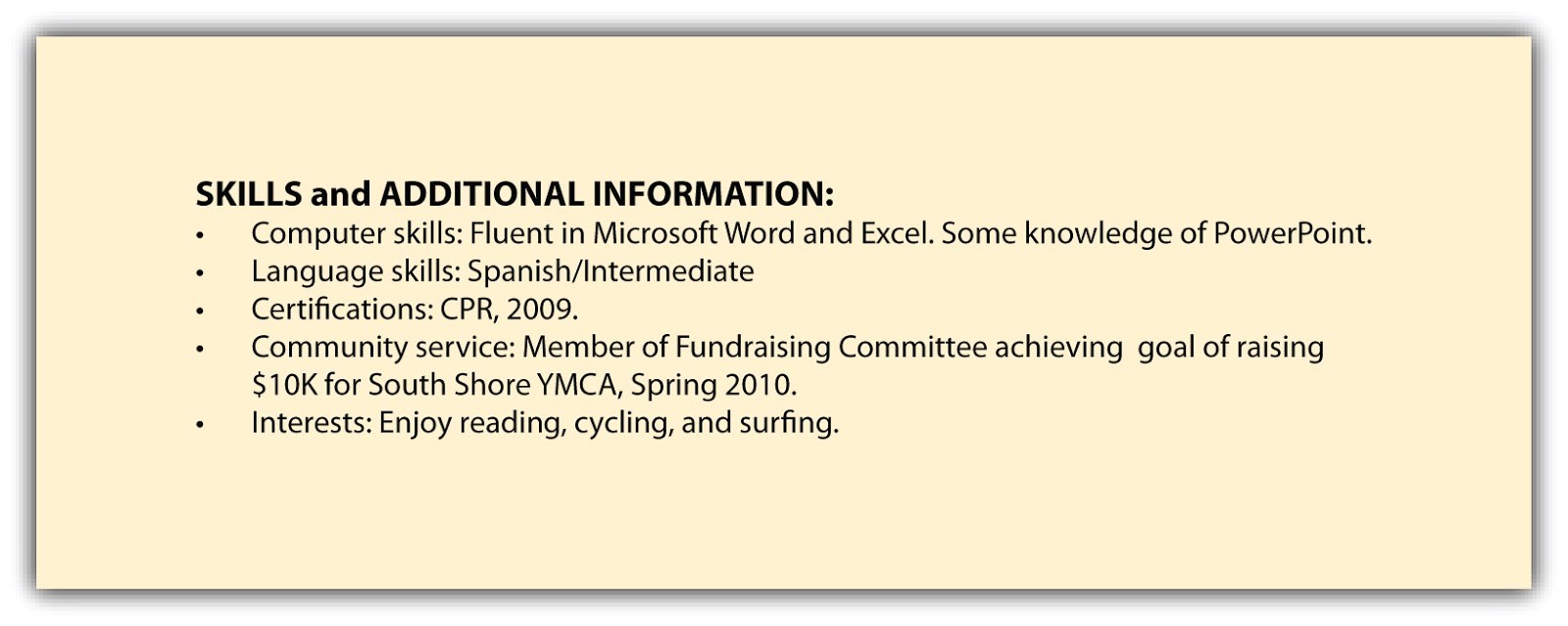
- References: One of the famous last lines of a résumé is References furnished upon request. This is not necessary because employers can simply ask for references when they want them. In fact, if you simply include a references page with your résumé, it may save an interested employer the trouble of having to ask in the first place; a proactive, impressive strategy would be to create a single-page document that includes the following information.
- Header (that matches the résumé header) to include your name, address, and contact information
- Reference’s name
- Reference’s company and title
- Reference’s relationship to you (e.g., manager, peer, vendor, and so forth)
- Reference’s contact information, including e-mail address and phone number
Be sure to notify those who have agreed to serve as references that they may be receiving a call or email from a potential employer.
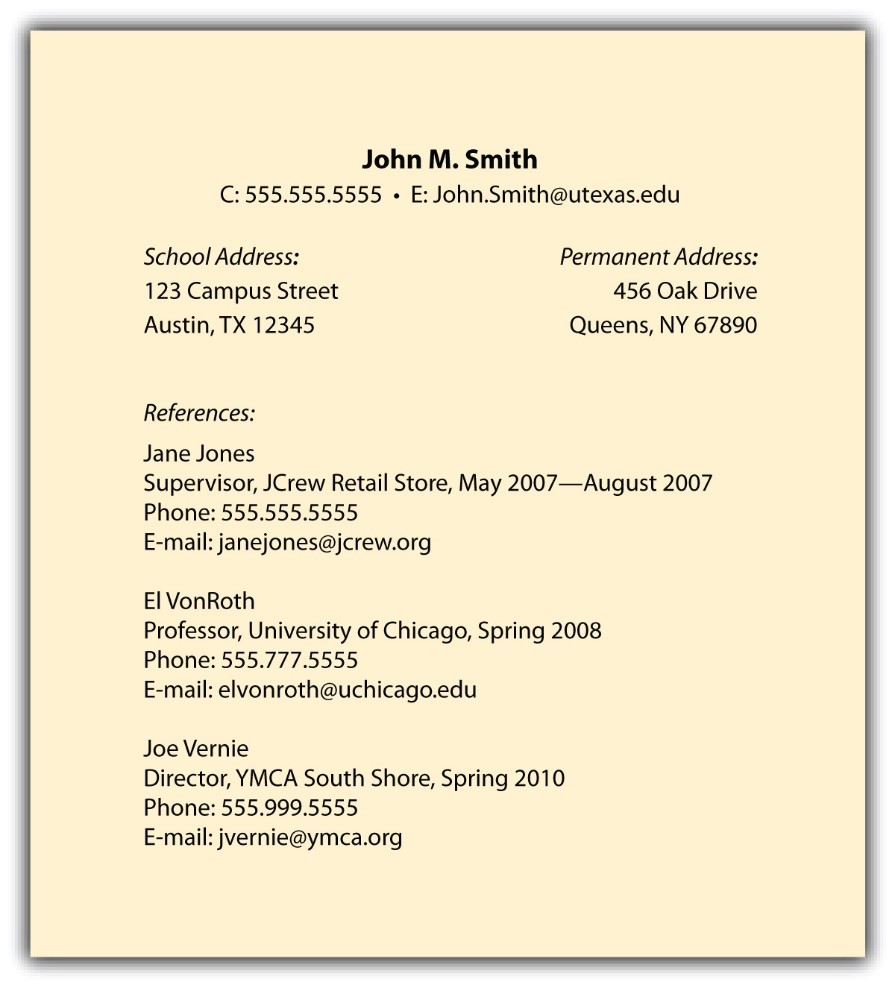
7.5 Writing Job Letters
In the era of social media, the idea of writing an application letter to introduce your résumé may seem outdated. However, the application letter still serves several crucial functions. If the résumé is characterized by breadth (giving a broad overview of your qualifications), the application letter is characterized by depth (choosing a few most significant qualifications to cover in detail). Written in paragraphs rather than bullet points, this letter is the first writing sample your employer will see from you. It offers an opportunity to market your unique qualifications and to show how you will fit with the culture of the company. An effective application letter will create a picture of you as a potential employee and inspire a potential employer to learn more about you. Keep the following tips in mind as you write your cover letter:
- Your letter is essentially an argument for why you should be granted an interview. Make sure to support the claim that you are qualified for the position with evidence.
- Demonstrate your authority by speaking in detail about your qualifications.
- SHOW the reader that you have the skills and abilities necessary to do the job at hand. The more detail you offer and the more precise your language is, the more the reader will be able to picture you doing the job.
- Consider your audience carefully as you craft your letter.
- Conduct additional research to help you connect with the company and to choose the appropriate tone, level of formality, and level of technicality.
At some point you may find yourself asking, “Is it worth writing an application letter knowing it might never be read?” The short answer is yes. Some recruiters go straight to the résumé and make an initial decision, while other recruiters carefully weigh the information in the letter. There is no way of knowing which will be the case, so you are better off putting your best foot forward every time. A well-written application letter is an opportunity to present yourself well and influence a recruiter, so always take full advantage of that opportunity. It can also be viewed as your first conversation with a future employer, so its quality should be exceptional.
When writing an application letter, remember that you have competition. Your audience is a professional who screens and hires job applicants—someone who may look through dozens or even hundreds of other applications on the day yours is received. The immediate objective of your application letter and accompanying résumé is to attract this person’s attention. The ultimate goal is to obtain an interview. As you write your application letter, strive to complete three tasks: 1) catch the reader’s attention favorably, 2) convince the reader that you are a qualified candidate for the job, and 3) leave a lasting impression.
Many people use the terms application letter and cover letter interchangeably. It is good to keep in mind, however, that they may refer to different business writing genres. The letter of application is much like a sales letter in which you market your skills, abilities, and knowledge. The term cover letter may refer to a document of transmittal sent with faxes or emails. It identifies an item being sent, the person to whom it is being sent, and the reason for its being sent, providing a permanent record of the transmittal for both the writer and the reader.
Deciphering the Job Description
Most job descriptions can be copied from the employer’s website. The previous section (Finding Job Openings) shares additional ideas on how to search for job ads. Once you have identified a position that interests you, copy the job description into a Word document. (If you only have a hard copy of the ad, it might be worthwhile to type it into a new Word document, so that you can copy pertinent phrases from the job description into your letter.) You can complete two prewriting steps before writing to decipher the job description: 1) List each skill and qualification on a separate line and 2) Group like with like. If communication skills are listed as important, in addition to giving presentations, list one after the other. An example of a job description and the deciphering process is given below.
Sample Job Description
Entry-Level Sales
The CML Company, a leading provider of recruiting and staffing services, is currently seeking motivated, career-oriented individuals to join our recruiting team. Our recruiters work with our clients and inside sales team identifying, screening, interviewing, and presenting qualified candidates for contract and permanent positions. CML promotes from within. Entry-level sales staff start as recruiters. Once they master that role and have a desire to become a member of our sales team, they can be considered for promotion. Qualified candidates for the recruiter position will:
- Develop recruiting strategies designed to identify qualified candidates through various recruiting tools.
- Evaluate candidates’ strengths compared with clients’ requirements by evaluating, screening, and interviewing the candidate.
- Negotiate wage rates and other terms and conditions of employment with candidates and gain commitment from candidates for current and future job requirements.
- Complete necessary pre-employment processes, including reference and background checks and drug tests.
- Work with account executives to identify top accounts, client skill sets, and key market segments, and to assess clients’ staffing requirements.
- Interact effectively with others to create a productive team environment.
- Communicate with peers by sharing recruiting best practices and providing accurate, thorough documentation on contract employees in our applicant-tracking system.
- Maintain relationships with industry contacts to provide customer service, gain industry knowledge, and get referrals and sales leads.
Qualified candidates for the recruiter position must also:
- Have a bachelor’s degree or related sales or recruiting experience.
- Be available to work before and after typical office hours as work may demand.
- Possess strong written and oral English communication skills.
- Be familiar with Microsoft Word and MS Outlook (or similar e-mail applications).
- Have work experience in a service-oriented business.
- Reflect a desire to learn and advance in a fast-paced sales environment, and be capable of regularly using good judgment and discretion to accomplish goals.
- Be currently authorized to work in the United States for any employer.
Sample Deciphering Process
As you consider the preceding sample, study each component of the job description and how it relates to your skills so that you can apply for and gain an interview for the position. Also simplify the job ad description as you list and group. Your streamlined (second) list of requirements might look something like this:
Requirements:
- Bachelor’s degree
- Able to work flexible, long hours
- Strong written and verbal communication skills
- Computer literate
- Desire to learn in a fast-paced sales environment
- Good judgment
- Discretion
- Authorized to work in the U.S.
As you compare your abilities and credentials to your list(s), ask yourself how closely your qualifications match the items are listed. Do your skills match all of these requirements, or the vast majority of them? Highlight the skills that do match and consider where you might reference them directly in your job letter. Your next step might involve identifying and writing down any requirements that are NOT stated directly. For example, the job ad seems to imply: 1) individuals must be motivated, 2) they must have the ability to master the work, and 3) they must have a desire to be a part of the sales team in order to be promoted.
Do not rule yourself out if every requirement does not match. Instead, think of something that is somewhat related. For example, if you have never worked in a fast-paced sales environment, focus on your desire to learn. Highlight the fact that you have observed fast-paced sales environments, and those situations appeal to you. At the very least, you could use the fact that you have always been very proactive in completing tasks as efficiently as possible. Or maybe you have taken a course or two in economics or marketing that might have provided tangentially relevant knowledge. In contrast, if you are a strong match for most of the requirements, generate specific, results-oriented examples to demonstrate these skills.
Oftentimes, you will not have a clear indication as to which skills are more important than others in the job ad, so use your best judgment call. Treat each skill as if it is the most important. For instance, when considering communication skills have a specific, results-oriented example of your verbal skills and your written skills. At some point, however, you will want to select the three skills you think are most important, match them to your strongest skills, and then write your cover letter. These three skills, if positioned properly, will make the case for why you should be hired.
Format and Structure
Formatting of all business letters—but especially the application letter—must be neat and professional. It is recommended that you use left alignment for all text, since various software programs can wreak havoc with indentations and tabs. Common business letter formats include the block letter, the semi-block letter, the alternative letter, and the simplified letter. Block format, among the most widely used business letter formats, is recommended for application letters. The application letter includes five main sections: 1) heading and greeting/salutation, 2) introductory paragraph, 3) middle paragraphs, 4) closing paragraph, and 5) complimentary close.
The heading contains the writer's address and the date of the letter. The writer's name is not included; only a date is needed in headings on letterhead stationery. Next comes the inside address, which shows the name and address of the recipient of the letter. This information can help prevent confusion at the recipient's offices. Also, if the recipient has moved, the inside address helps to determine what to do with the letter. In the inside address, include the appropriate title of respect of the recipient, and copy the name of the company exactly as that company writes it. When you do have the names of individuals, remember to address them appropriately: Mrs., Ms., Mr., Dr., etc. If you are not sure what is correct for an individual, do some extra online research and/or consider using the title that the individual prefers. Another standard rule of thumb is to use Ms. if unsure of a woman’s marital status.
The greeting or salutation directly addresses the recipient of the letter and is followed by a colon. If you do not know the recipient’s gender, you may use the full name. Again, the best solution is to do a little extra research, or make a quick, anonymous phone call to the organization and ask for a name. In some cases, you may address the salutation to a department name, committee name, or position name: Dear Personnel Department, Dear Recruitment Committee or Dear Hiring Committee.
In the introductory paragraph, you introduce yourself to the hiring manager or recruiter. The paragraph should include these general items:
- Why you are contacting them (to apply for X position—give its specific name).
- How you heard about the position (for example, give the name of the website where you found the ad).
- The date of the ad if applicable.
- What the minimum requirements for the job are and how you meet them (for example, if the job requires a degree and three years of experience, you will want to mention right away that you meet these requirements).
- Optional: Something specific about the company or the job itself that has made you interested in the position (for example, does the company have a good environmental track record? Do they mention on their website that they like to promote from within? Have they won awards? Are they working on any projects that pique your interests?).
| When the job ad requires... | You might write... |
|---|---|
| Introductory lab experience | During the summer of 2016, I interned for Johnson & Johnson, where I acted as the assistant laboratory supervisor. I was tasked with performing gram stain testing, assessing bacterial antibiotic resistance, and completing routine safety checks. |
| Strong writing skills | During fall of 2019, I took Technical Writing at OSU, where I created documents in the following professional writing genres: emails, business letters, technical instructions, internal proposals, and external analytical reports. |
The middle paragraphs of the cover letter should make the case for why you would be an exceptional hire. Select two to four strengths necessary to excel and assign each strength to a bulleted section or brief paragraph. Boldly indicate your strengths and include your best examples of how you excel at each strength. For a one-page application letter, some candidates have two paragraphs, while others have three. Oftentimes, one of these paragraphs will focus on education and the ways it has prepared the candidate for the position, while another discusses work experience and applies skills learned to the position. Anything listed as a strength in the résumé needs to include visible proof of that strength. For example, if you mention having strong interpersonal skills, be sure to give a concrete example, like writing about a course that required group work to finish a large project. Again, be specific. Show exactly how the event built or showcased the skill you reference.
The closing paragraph should reiterate any major points or takeaways that you want readers to remember. It will likely do the following:
- Re-state your interest.
- Highlight how your strengths mesh well with the required skills.
- If applicable, inform them when you will contact them within a certain time period.
- Invite them to contact you (and include contact information, typically your professional email address).
- Refer them to your enclosed résumé.
- Thank them for their time and consideration.
The Sincerely element of the business letter is called the complimentary close. Other common ones are Sincerely yours, Respectfully, or Thank you. Notice that only the first letter is capitalized, and it is always followed by a comma. Usually, you type your name four lines below the complimentary close and—if the letter is a physical copy—sign your full name in between.
Concluding Thoughts
Preparation and practice are critical to every step of the job search process, and the cover letter is no different. Five actions can help make your cover letter compelling:
- Make a list of your top ten strengths.
- Make a list of your top five weaknesses (areas you would like to strengthen).
- Decipher the job description to identify each separate skill and qualification.
- Compare the two lists to see if they are in alignment. Also identify the gaps—does the job description list something that you haven’t done?
- Highlight your top skills that align with the job description as you will use them in Other strengths and skills could include (in alphabetical order).
Sample Job Letters


7.6 Sample Student Job Packet (see proper student attribution)
Click here to download a copy of the Sample Job Packet.
Sample List Created from Job Ad
JOY Ranch Company
Role and Responsibilities Duties of the Horse/Breeding Manager, who will see to horses’ breeding, foaling, management, etc.:
- Feed horses
- Care for sick animals
- Administer routine treatments
- Address emergency situations
- Assist medical personnel as needed
- Drive horses to specified locations
- Schedule various appointments
- Order necessary supplied
- Catalog supplies
- Deal with equipment maintenance and operate machines
- Address maintenance needs
7.7 Interviewing
Interviewing for a job position comes with its own set of challenges. However, having made it to this moment in the hiring process means that you have already faced and beat many obstacles. Be encouraged! Even if you do not receive (or accept) a job offer after interviewing, the interview itself provides valuable preparation for career advancement. Some universities offer mock interviews to help students prepare, so you may want to check with your adviser, department, and career services to be aware of these opportunities. There are ways of preparing for possible interview scenarios—for example, drafting a set of potential questions that you may be asked and writing out or speaking possible responses in advance. Keep your support system involved. Just as you may have asked family or friends to look over job materials, so also might you ask a friend or family member to help you practice responding to interview questions. The following information is not meant to be a comprehensive guide to interviewing; however, it will provide you with information on the types of interviews that you may encounter.
On-Campus Recruiting
If you are participating in on-campus recruiting (when a company comes onto your campus to recruit), three interview scenarios are possible: open, closed, or mixed schedule. The school dictates the type of schedule, and it is important to know in which type you are participating.
- An open schedule allows any student to go to the career services office to submit their résumé for the specific position in which they are interested. An open schedule is open to any candidate who wishes to be considered for an interview. The company recruiter will then review all of the résumés and select the top ten or twelve candidates they will interview on campus. (For example, thirty-minute interview schedules would allow for twelve students to be interviewed, while forty-five-minute interview schedules would allow for nine students to be interviewed.) The company will select the length of interviews when they initially book the schedule with career services.
- A closed schedule happens when the recruiter selects all of the ten or twelve individuals they will interview from the résumé book, from interactions they have had on campus, or from a colleague’s recommendation. Perhaps they met a student who impressed them at a marketing event. The recruiter could choose to include that student in a closed schedule.
- A half open/half closed schedule is a hybrid of the two preceding schedules. Half the students will be selected from students who have submitted their résumés, and the recruiter will select the other half from the résumé book, a recommendation, or a direct interaction with students while they were on campus.
Whether you submit your résumé for an open schedule, or you are selected to participate in a closed schedule, the recruiting cycle is fast-paced and résumés can be easily missed due to no fault of the job seeker and résumé writer. Sometimes recruiters review hundreds of résumés to find the ten or twelve they will pursue, and sometimes résumés can be missed because of something as simple as pages sticking to one another. Should your résumé be one of the many that is not selected, you can write to the recruiter, using your cover letter to make a strong case for why you should be considered. In some cases, this may work to get you an interview. The recruiting process is not perfect, so it is recommended that you apply for as many positions as possible. Never rely solely on the submission of one résumé. Instead, when on-campus recruiting takes place, apply for all positions that fit your strengths and interests.
Off-Campus Recruiting
Do not limit your search to only on-campus opportunities because off-campus opportunities can also be fruitful. Conducting both an on-campus and off-campus job search increases the number of opportunities you can consider. You may pursue off-campus opportunities for three reasons:
- Your school does not have a robust career services department that attracts a variety of employers.
- You are interested in a company that does not recruit on campus.
- You want to hedge your bets to have as many opportunities as possible, representing a mix of on-campus and off-campus possibilities.
The main difference between on-campus and off-campus recruiting is that in off-campus recruiting, you manage the entire process. You are responsible for getting your résumé into the hands of the company recruiters or hiring managers, along with scheduling the interview and following up on your own. An off-campus job search demands that you are organized and proactive enough to keep things moving. One final thought: After completing a job interview, always send a follow-up letter thanking interviewers for their time; this additional step demonstrates your professionalism and attention to detail.
7.8 Activities and Resources
As you work on your résumé, you may worry that you have nothing valuable to include, or you may feel that you sound like you are bragging. One way to get over these hurdles is to allocate pre-writing time to a self-inventory. Brainstorm your skills, accomplishments, and knowledge. What did you accomplish at work, school, or a volunteer position? What skills have you learned? What would you tell a friend or family member you were proud of having achieved there? What sort of technical advice do friends and family members seek from you? Start writing down key terms and action verbs that describe your experiences and accomplishments, but do NOT worry yet about putting them into a résumé format.
Action Verb Activity
Here are some action verbs that may be helpful to use in your résumé sections.
| · Accomplished
· Analyzed · Assisted · Calculated · Circulated · Clarified · Collected · Conducted · Decreased · Directed · Distributed · Documented · Edited · Eliminated · Expanded · Expedited · Facilitated |
· Generated
· Influenced · Introduced · Investigated · Joined · Led · Located · Maintained · Managed · Marketed · Negotiated · Organized · Programmed · Provided · Resolved · Responded · Reviewed |
· Showed
· Standardized · Structured · Supplied · Supported · Surveyed · Taught · Trained · Updated · Used · Utilized · Verified · Won · Worked · Wrote |
Attribution
Material in this chapter was adapted from the works listed below. The material was edited for tone, content, and localization.
Technical Writing, by Allison Gross, Annamarie Hamlin, Billy Merck, Chris Rubio, Jodi Naas, Megan Savage and Michele DiSilva, licensed CC-BY-NC-SA.
ENGL 145 Technical and Report Writing, by the Bay College Online Learning Department, licensed CC-BY.

